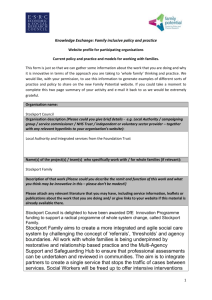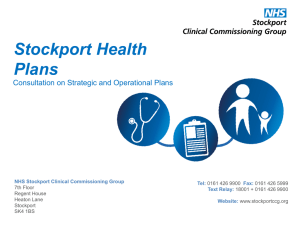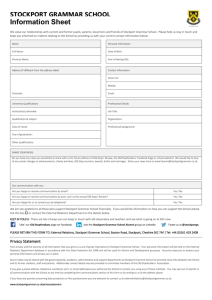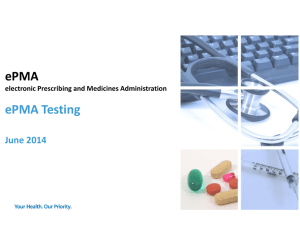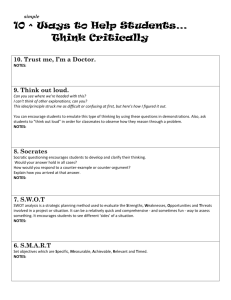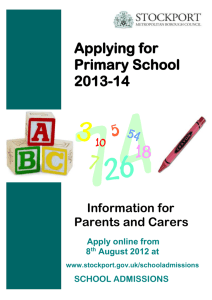EIA – Health App - NHS Stockport Clinical Commissioning Group
advertisement
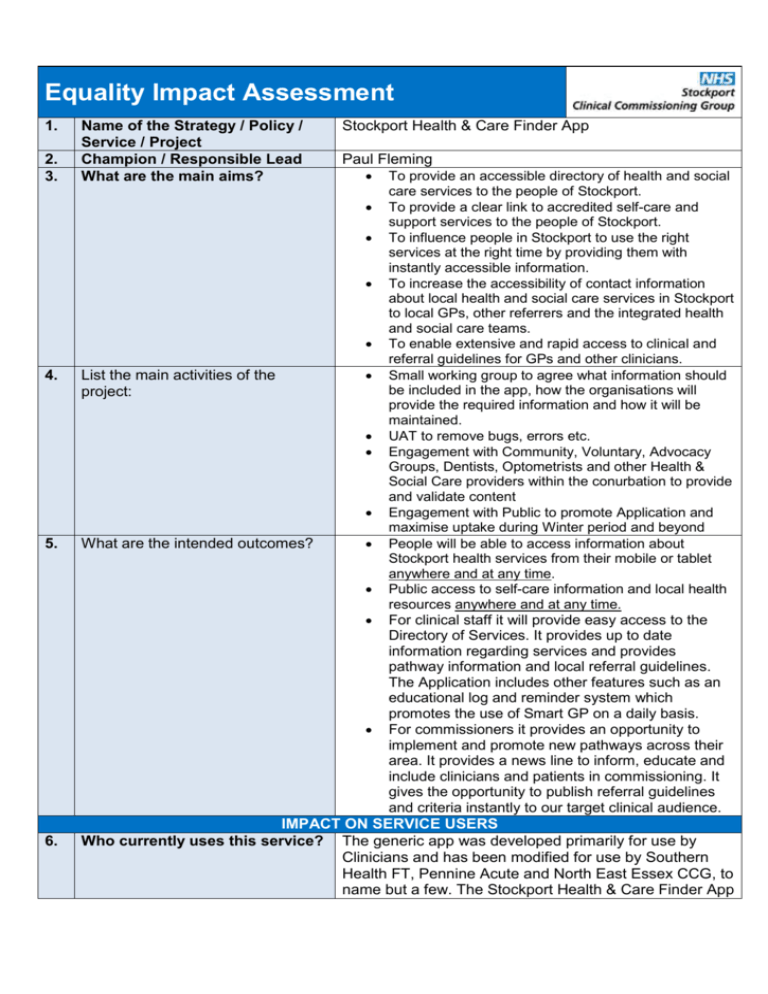
Equality Impact Assessment 1. 2. 3. Name of the Strategy / Policy / Service / Project Champion / Responsible Lead What are the main aims? Stockport Health & Care Finder App Paul Fleming 4. List the main activities of the project: 5. What are the intended outcomes? 6. To provide an accessible directory of health and social care services to the people of Stockport. To provide a clear link to accredited self-care and support services to the people of Stockport. To influence people in Stockport to use the right services at the right time by providing them with instantly accessible information. To increase the accessibility of contact information about local health and social care services in Stockport to local GPs, other referrers and the integrated health and social care teams. To enable extensive and rapid access to clinical and referral guidelines for GPs and other clinicians. Small working group to agree what information should be included in the app, how the organisations will provide the required information and how it will be maintained. UAT to remove bugs, errors etc. Engagement with Community, Voluntary, Advocacy Groups, Dentists, Optometrists and other Health & Social Care providers within the conurbation to provide and validate content Engagement with Public to promote Application and maximise uptake during Winter period and beyond People will be able to access information about Stockport health services from their mobile or tablet anywhere and at any time. Public access to self-care information and local health resources anywhere and at any time. For clinical staff it will provide easy access to the Directory of Services. It provides up to date information regarding services and provides pathway information and local referral guidelines. The Application includes other features such as an educational log and reminder system which promotes the use of Smart GP on a daily basis. For commissioners it provides an opportunity to implement and promote new pathways across their area. It provides a news line to inform, educate and include clinicians and patients in commissioning. It gives the opportunity to publish referral guidelines and criteria instantly to our target clinical audience. IMPACT ON SERVICE USERS Who currently uses this service? The generic app was developed primarily for use by Clinicians and has been modified for use by Southern Health FT, Pennine Acute and North East Essex CCG, to name but a few. The Stockport Health & Care Finder App 7. Are there any clear gaps in access to this service? (e.g. low access by ethnic minority groups) 8. Are there currently any barriers to certain groups accessing this service? (e.g. no disabled parking / canteen doesn’t offer Kosher food / no hearing loop) How will this project change the service NHS Stockport offers? (is it likely to cut any services?) 9. 10. If you are going to cut any services, who currently uses those services? (Will any equality group be more likely to lose their existing services?) 11. If you are creating any new services, who most likely to benefit from them? (Will any equality group be more or less likely to benefit from the changes?) has been the first iteration directed primarily at the Public to provide a directory of local services. The Application is only available to owners of I-Phone and Android Smart Phone and Tablet owners. There is no provision for Windows Smart Phone owners or those without Smart Phones. As above. This will not cut any services, rather enhance the ability of the public to access local services. Push messages can be issued by the CCG to communicate, effectively reaching their target audience. There is also the ability to collect information from users i.e. Friends & Family Testing. N/A Evidence from Deloittes, 2013 has shown that 72% of people in the UK now own a smartphone, 89% of people between 25 and 30 are the most likely to own a smartphone. Followed by 85% of 16 to 24 year olds and 54% of 54 to 65 year olds. Within Stockport, in May 2013, a sample of 1064 residents took place, with 300 undertaken in Priority areas (Adswood, Brinnington and Town Centre) and 700 in Non-Priority areas. 83% of respondents possess a mobile phone. Mobile phones ownership was highest amongst those in Non-Priority areas (84% v 75%), those under 55 and those without a disability. 51% of respondents use their phones for internet use. Stockport Homes conducted an exercise in Priority areas and interviewed 720 respondents. 31% of these people owned a smartphone which is in line with the national trend and does not support the previous thought that social housing tenants are in the main digitally excluded. As previously mentioned, the App is currently available to Android and I-Phone/I-Pad devices only 12. How will you communicate the changes to your service? (What communications methods will you use to ensure this message reaches all community groups?) Card Drop and Engagement in Supermarkets, Town Centre, GP practices, Pharmacies, Opticians, Dentists, Estate agents, Nurseries, Schools, Local businesses, District nurses, Mastercall, Libraries, Mother and baby groups, Maternity Services, Luncheon clubs, Churches and faith groups, Stockport College, Choices centre, Social Workers Press Release, Healthwatch Article, Stockport People Article FT, Council & GP TV Screens Social Media comms FT Staff Bulletin and Intranet Engagement with charities, Voluntary organisations, Advocacy agencies, Community support groups, A&E patients, Neighbourhood management, Lifestyle service, Fire service and other community groups. 13. What have the public and patients said about the proposed changes? (Is this project responding to local needs?) 14. Is this plan likely to have a different impact on any protected group? (Can you justify this differential impact? If not, what actions will you add into the plan to mitigate any negative impacts on equality groups?) Age Carers Disability By marketing the app in targeted locations we can encourage high users of NHS services to use the app. ED waiting time performance is high. Some of the users of ED that do not need to be there can be targeted within the service by advertising the app on hospital TV screens and via flyers. For those people with ACS conditions that do need to be in hospital, the app will be able to link them to information about expert patient courses and detailed information on managing long term conditions. For GPs the app can support effective prescribing and adherence to appropriate guidelines, for example, for healthcare acquired infections like C-Diff. It will support the communication between consultant and GP by ensuring that information or instructions about hospital systems and processes are easily accessible. By providing simpler access to information using personal devices we are enabling patients to take responsibility for finding their own information and advice from reputed sources. This will further support them to take control of their own health. The Smart GP app provides advice and information when people go looking for it. In addition, it provides the CCG with the opportunity to target the users with healthy lifestyle alerts that support them in preventing ill health. It can also send out reminders about health check and screening entitlements. IMPACT It is often assumed that only the younger generation use new technologies N/A Potential differential impact on people with sensory loss MITIGATION The rise of the silver-surfer dispels this myth. There is scope within the engagement plan to provide demos and ensure the app is adopted by all age-groups. Existing communications methods will continue to be used – this is merely an additional source of access to information N/A Local engagement has shown that the deaf and hard of hearing community prefer the use of mobile phones / online communications. Similarly, voicereader technology on phone and iPads will open up this new communication avenue to blind and partial sighted people. This Gender Reassignment Marriage / Civil Partnership Pregnancy & Maternity Race N/A N/A N/A Potential differential impact on people with limited English Religion & Belief Sex Sexual Orientation N/A N/A N/A represents a positive impact which is objectively justifiable under the Equality Act in its active support of increased access to a protected group. N/A N/A N/A Online technology allows for easier use of translation facilities. Existing communications methods will continue to be used – this is merely an additional source of access to information. N/A N/A N/A IMPACT ON STAFF 15. How many staff work for the Programme Manager (Paul Fleming) current service? Comms Team (<5 staff) 16. What is the potential impact on Increased workload during promotional campaign. these employees? (including Ongoing maintenance of app content (approx. few hrs potential redundancies, role per month). changes, reduced hours, changes in terms and conditions, locality moves) 17. Is the potential impact on staff likely to be felt more by any protected group? If so, can you justify this difference? If not, IMPACT MITIGATION what actions have you put in place to reduce the differential impact? Potential training Existing communications methods Age requirements for staff with limited IT skills will continue to be used – this is merely an additional source of access to information. N/A N/A N/A N/A N/A N/A N/A N/A N/A N/A Carers N/A Disability N/A Gender Reassignment N/A Marriage / Civil Partnership N/A Pregnancy & Maternity N/A Race N/A Religion & Belief N/A Sex N/A Sexual Orientation 18. What communication has been Staff have undertaken training on maintenance of undertaken with staff? content and have an engagement plan in place. N/A 19. Do all affected workers have genuinely equal opportunities for retraining or redeployment? IMPACT ON STAKEHOLDERS 20. Who are the stakeholders for the Stockport CCG, Service Providers contained within service? content, General Public 21. What is the potential impact on these stakeholders? 22. What communication has been undertaken with stakeholders? 23. What support is being offered to frontline staff to communicate this message with service users / family / carers? 24. How will you monitor the impact of this project on equality groups? Easier access to local services, can build their own personal directory through ‘favourites’. Targeted messaging. Ongoing Engagement with all Stakeholders through course of project Clear engagement plan in place to ensure target audience is reached and content is accurate and kept up-to-date Ongoing engagement with the public Survey to users to gauge effectiveness Feedback button on app to capture any issues EIA SIGN OFF 25. Your EIA should be sent to Head of Strategic Development for approval and publication: angela.dawber@nhs.net 0161 426 5610 Date of EIA Approval: 01/12/2014
